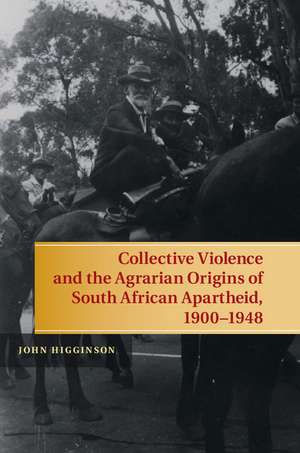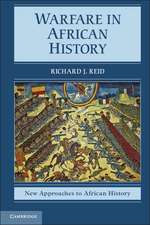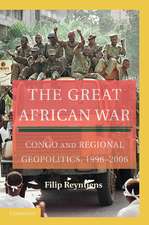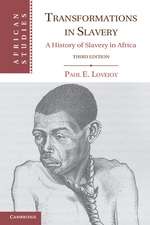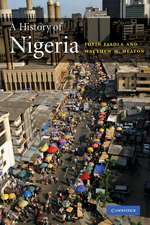Collective Violence and the Agrarian Origins of South African Apartheid, 1900–1948
Autor John Higginsonen Limba Engleză Hardback – 23 noi 2014
| Toate formatele și edițiile | Preț | Express |
|---|---|---|
| Paperback (1) | 318.87 lei 6-8 săpt. | |
| Cambridge University Press – 5 apr 2017 | 318.87 lei 6-8 săpt. | |
| Hardback (1) | 473.57 lei 6-8 săpt. | |
| Cambridge University Press – 23 noi 2014 | 473.57 lei 6-8 săpt. |
Preț: 473.57 lei
Preț vechi: 532.10 lei
-11% Nou
Puncte Express: 710
Preț estimativ în valută:
90.66€ • 94.24$ • 75.17£
90.66€ • 94.24$ • 75.17£
Carte tipărită la comandă
Livrare economică 05-19 februarie 25
Preluare comenzi: 021 569.72.76
Specificații
ISBN-13: 9781107046481
ISBN-10: 1107046483
Pagini: 410
Ilustrații: 17 b/w illus. 3 maps
Dimensiuni: 152 x 229 x 27 mm
Greutate: 0.7 kg
Ediția:New.
Editura: Cambridge University Press
Colecția Cambridge University Press
Locul publicării:New York, United States
ISBN-10: 1107046483
Pagini: 410
Ilustrații: 17 b/w illus. 3 maps
Dimensiuni: 152 x 229 x 27 mm
Greutate: 0.7 kg
Ediția:New.
Editura: Cambridge University Press
Colecția Cambridge University Press
Locul publicării:New York, United States
Cuprins
Part I. The Ashes of Defeat: 1. Introduction; 2. The etiology of guerrilla organization in the western Transvaal, July 1900 to December 1902; 3. Peonage or empire?: the reconstruction of white supremacy; 4. Milnerism, the Chinese labor experiment, and the advent of Het Volk; Part II. Sidestepping the King's Writ: 5. Ministering to the dry bones of white supremacy: from union and the 1913 Natives Land Act to the 1914 rebellion; 6. A glass brimming over: the failed 1914 rebellion in Rustenburg and Marico; 7. Turbulent cities, smoldering countryside, 1914–22; 8. After the rebellion, before the pact, 1919–24; Part III. A Hoofdliere or Boere Republic?: 9. The pact, the depression, and the stillborn republic, 1924–33; 10. A thousand little Hoofdlier, 1934–48; Epilogue.
Recenzii
'From the epochal devastation of the South African War to the tyrannies of neo-fascists, Collective Violence and the Agrarian Origins of South African Apartheid, 1900–1948 explores the role of violence in the making of white supremacy. Higginson guides us through the transformation of South Africa's rural worlds, the anxieties and turmoil that consumed people's lives, and the violence that has profoundly shaped the country's history. Richly researched and closely argued, this timely book is an important reminder of a not-too-distant past, and of the troubling violence in South Africa today.' Clifton Crais, Emory University, Atlanta
'John Higginson has given us a fast-paced and engaging history of the way in which agrarian policy, poverty, war, gender, and age play intersecting roles in the creation and spread of violence. Carefully researched and thoughtfully argued, the text brings us into the inner lives of politicians, poor whites, African smallholders, and British imperialists, showing how and why they came to see violence as the most effective way to solve a range of tactical political problems. Higginson sheds new light on the roots of political violence in South Africa, and his work is a must-read for policy makers, scholars, and activists who want to understand the roots of violence in the past in order to find ways to prevent it in the future.' Zine Magubane, Boston College
'How are nations carved from empires, and then made and remade? This deeper question drives John Higginson's magisterial account of the South African experience from the imperial war of 1899–1902 to the rise of apartheid in 1948. Recondite of research, adroit of argument, tantalizing of telling, and passionate of spirit - for his is not a dispassionate subject - Higginson's book is indispensable for appreciating Mandela's South Africa. A monument to South African and African historical studies.' Michael West, State University of New York, Binghamton
'The argument of this deeply researched and attractively written book is that rural power and violence is central to the understanding of modern South African history and, further, that these dynamics underlie the evolution of the system of racial segregation into full-scale apartheid … Higginson ends by speculating that South Africa's long history of collective violence, past and present, leaves deep scars and he ventures that it is entirely possible that the future will continue to be turbulent. It is a sober conclusion, and not one that is easy to discount.' The American Historical Review
'The book provides a fine-grained detail of how the countryside became an arena of struggle and violence between the Afrikaner farmers, the British occupiers, and African smallholders, for about five decades up to the official birth of apartheid in 1948. It demonstrates how official and extralegal collective violence were crucial in securing a boerestad (white homeland), while also transforming the countryside. The book also contributes a fresh and rich detail of African people's agency in dealing with both their threatened land-based livelihoods and the violence they were confronted with … researchers on land reform, current service delivery protests in South Africa, peace research, as well as policy-makers, should find this book very useful. The preface and the introductory chapter of the book begin with the present and familiar, to set the scene for understanding and appreciating the detail that follows in subsequent chapters.' Thembela Kepe, Safundi: The Journal of South African and American Studies
'John Higginson has given us a fast-paced and engaging history of the way in which agrarian policy, poverty, war, gender, and age play intersecting roles in the creation and spread of violence. Carefully researched and thoughtfully argued, the text brings us into the inner lives of politicians, poor whites, African smallholders, and British imperialists, showing how and why they came to see violence as the most effective way to solve a range of tactical political problems. Higginson sheds new light on the roots of political violence in South Africa, and his work is a must-read for policy makers, scholars, and activists who want to understand the roots of violence in the past in order to find ways to prevent it in the future.' Zine Magubane, Boston College
'How are nations carved from empires, and then made and remade? This deeper question drives John Higginson's magisterial account of the South African experience from the imperial war of 1899–1902 to the rise of apartheid in 1948. Recondite of research, adroit of argument, tantalizing of telling, and passionate of spirit - for his is not a dispassionate subject - Higginson's book is indispensable for appreciating Mandela's South Africa. A monument to South African and African historical studies.' Michael West, State University of New York, Binghamton
'The argument of this deeply researched and attractively written book is that rural power and violence is central to the understanding of modern South African history and, further, that these dynamics underlie the evolution of the system of racial segregation into full-scale apartheid … Higginson ends by speculating that South Africa's long history of collective violence, past and present, leaves deep scars and he ventures that it is entirely possible that the future will continue to be turbulent. It is a sober conclusion, and not one that is easy to discount.' The American Historical Review
'The book provides a fine-grained detail of how the countryside became an arena of struggle and violence between the Afrikaner farmers, the British occupiers, and African smallholders, for about five decades up to the official birth of apartheid in 1948. It demonstrates how official and extralegal collective violence were crucial in securing a boerestad (white homeland), while also transforming the countryside. The book also contributes a fresh and rich detail of African people's agency in dealing with both their threatened land-based livelihoods and the violence they were confronted with … researchers on land reform, current service delivery protests in South Africa, peace research, as well as policy-makers, should find this book very useful. The preface and the introductory chapter of the book begin with the present and familiar, to set the scene for understanding and appreciating the detail that follows in subsequent chapters.' Thembela Kepe, Safundi: The Journal of South African and American Studies
Descriere
This book examines violence against the rural African population and Africans in general before apartheid became the justification for the existence of the South African state.
